 |
||
|
||
| ||
In contrast to the science fiction world, in the real world the integration of computers and home equipment hasn't come to the successful end. Every hi-tech device has its own control system based on one or another microcontroller/processor, but you can't use it for surfing the Internet, typing texts or playing games. As to PC based music, it develops quite well, though it's the inverse process: as soon as PC become able to make one more step towards an audio center, they makes. The first step was made when charming PC screamers were supplemented with the special multimedia devices (CD-ROM and Sound Blaster :)). But since the radio sets were spread much wider, FM tuners were never that popular though they are not new on the market. The attempts to use such functionality for making audio centers were also made before: you might remember some technologies from board makers like ASUS Instant CD or AOpen JukeBox (/FM) which supported Audio CD playback or radio broadcasting without OS booting, or a finished solution named VIA Hi-Fi PC. A potential downside of such solutions was noise made by the CPU cooler (though such boards usually support intelligent fan speed control technologies) and limited functionality of the multimedia program flashed in BIOS. Such limitation is especially well seen in comparison with features available under the OS which offers a great deal of multimedia players of various appearances, support of various audio effects, codecs, data formats, loading of album info via the Internet etc. Besides, the startup time of modern computers runs into several seconds thanks to one more magical function called Hibernate and is comparable to the startup time of audio centers. However, today we have a different product. A miniature barebone system MSI Mega PC combines high-performance PC functionality and a module that allows using this system as a separate audio center. Was it worth making such device? We hope, our review will answer it question. Audio center modeLet's start from usual features especially because they become available right after the system is turned on. The appearance of the Mega PC (by the way, Mega stands for MSI Entertainment and Gaming Appliance) is identical to cubes from Shuttle, Iwill and others; the only difference is a LED screen on the front panel. 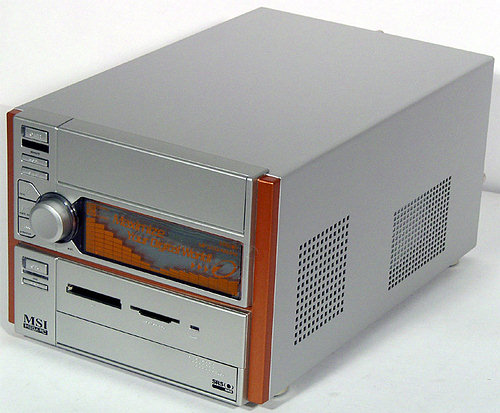 Turn on the audio center by pressing the button in the upper left-hand corner (the upper buttons look typical of Hi-Fi centers - they have small steps and a clear click) or the Hi-Fi button on the remote control,  it's especially impressive in the dark: 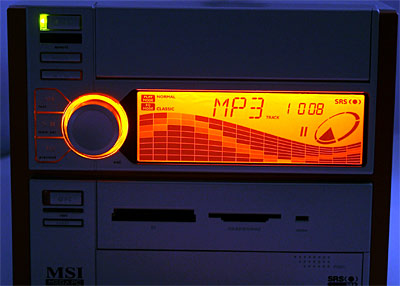 The center has two functions: playback of CD audio files (both Audio CD and mp3 files) and reception of AM and FM radio stations. A typical feature of home equipment often used in the PC world is remote control, and in this respect this model looks excellent. 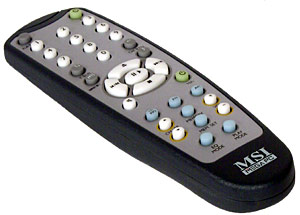 The remote control supplied with the Mega PC combines functions for operation with the Hi-Fi module and with an optional TV tuner from MSI (TV Anyware Master PCI deprived of an AM/FM tuner). The remote control duplicates buttons from the PC front panel without providing access to exclusive features (though there are not many of them), but it's still more convenient to handle the center with this control. The RC works from two AAA batteries supplied; the control itself is light and nicely fits in the hand. The only thing we didn't like was that the buttons are too small and hard to press. Now let's closer examine both functions of the audio center. Radio receivingThe automatic search finds only several stations in both frequency ranges (in case of bad reception conditions it can find no stations at all). The problem is not in the regional settings since our sample has these parameters set correctly. The problem can be solved by booting the Windows and installing the Mega Radio program from the CD. In its settings you must set the country and air scanning parameters. However, with the RC you can quickly switch from one station to another by entering its frequency. Without the RC you can start scanning the whole frequency range and stop it manually at a frequency required. Such methods are not convenient, but fortunately, the tuner can memorize 6 stations. However, the information on them is recorded into the volatile flash which gets cleared every time you unplug the cable or the power supply breaks down. Besides, the number of presets is not great as it's limited by this memory size. 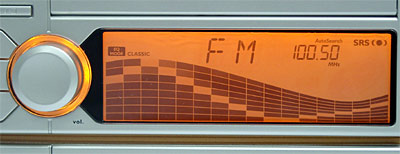 On switching to a certain frequency the LED displays the current mode (FM/AM) and the reception frequency, while the band of pseudo graphics adds beauty to it :). The equalizer has 4 standard presets influencing the way this band changes. Apart from the equalizer there is one more audio feature: SRS (Sound Retrieval System). This technology was developed by SRS Labs and adds 3D effects to an ordinary stereo signal. The Mega PC enables SRS in any audio modes available, but we don't recommend it in case of low-bitrate MP3 compositions since the distortions level becomes too high.  Here is how the tuner looks when mounted onboard. CD audio playbackIn this mode the Mega PC scans a CD inserted and estimates whether it can be played as Audio CD or MP3 and displays "CD" or "MP3" respectively.  If a multisession disc has at least one Audio CD session, the disc is considered to be Audio CD, and MP3 files recorded in different sessions can't be played. Otherwise it reads the CD content and all MP3 files found are transferred into a single list ready for reproduction. Neither long nor cyrillic names become an obstacle (the Mega PC doesn't display such names afterwards). Fortunately, it has no problems with CBR, VBR and ABR formats, as well as with resampling and nonstandard bitrates. A composition played has its number in the list and elapsed time displayed. Besides, the progressive wave below is supplemented with circulating sectors above. 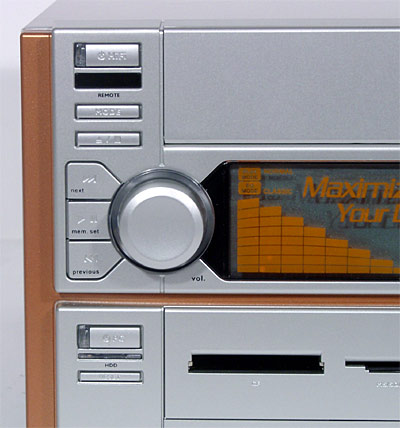 The playback control with the RC and front panel buttons is standard... though it doesn't support track forward/back wind. That's all about functionality of the Mega PC in the audio center mode. 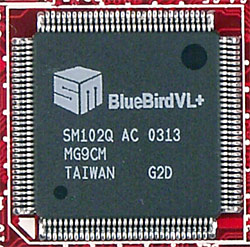 However, the chip offers much more capabilities: BlueBird VL+ supports IDE/ATAPI (and certainly CF) interfaces and SD/MMC, reads discs formatted for FAT16/32 and FAT12/16 respectively, that is why they could have made it possible to play music from the hard drive or flash cards, though CDs are not expensive these days and looking for a certain composition on a hard drive can take a lot of time and could please mostly those who prefer the random mode. 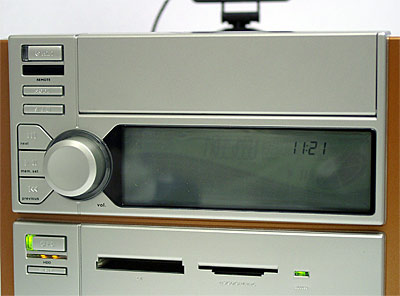 The most unpleasant thing is that you can't turn back to the audio center mode once you pressed the PC button on the front panel without rebooting the PC. The screen will display only the time (in the PC mode time is taken from CMOS, and it can differ from the audio center time). However, with the Mega Radio program it displays the info on radio reception. But the worst thing is that the RC doesn't operate in the PC mode. And there is nothing to do with it, unlike with the LED screen which depends on the SMI chip the upgrade of which can bring more info on the screen (by the way, in the first firmware versions the screen worked only in the audio center mode). Unfortunately, the RC becomes useless when you switch to the PC mode, as well as a DVD disc inserted until the OS is booted. PC modeAppearance and expandabilityNow we are going to see how it works in the other mode, especially because the modes do not intersect. The exterior (except the upper front panel) is similar to multiple Shuttle XPC versions and models from other companies. The aluminum case measuring 202x320x151mm is pretty light; it has a couple of more air holes and low legs covered with metal or metal-like plastic, that differ it from other devices of this kind; the legs are an evident sign of positioning this system on the level of hi-tech home equipment. 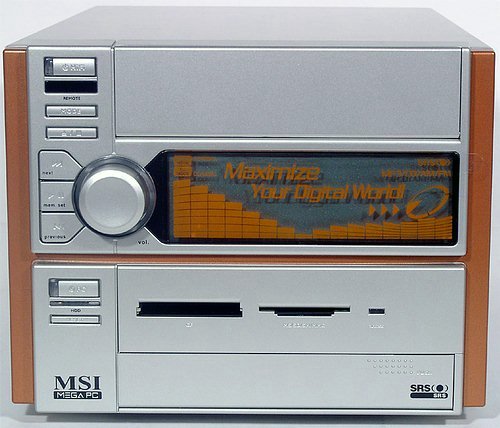 The front panel is covered with silvery plastic with dark orange framing to match the LED image. This fall MSI plans on releasing the second model of the Mega PC series - Mega400 (the current one is officially named Mega651 or MS-6251) on the nForce2 Ultra 400 under the Athlon XP. The new model will have a green-colored design. There are two bays available: the upper one is automatically covered with a lid (which is excellently combined with the CD/DVD drive tray), and the lower one is designed for a universal card reader which supports CFI/CFII/MD, SMC, SD/MMC and MS. The card reader can be replaced with an ordinary floppy disc drive, and there is a matching shield for the front panel of this device. If you don't want either of them, you can close the hole with a solid shield. 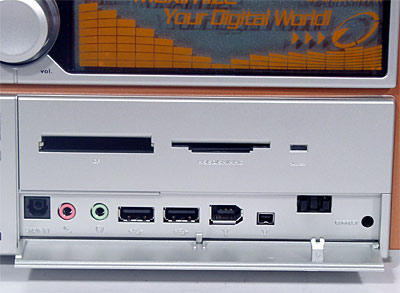 Behind the cover located below you can find interface connectors - optical S/PDIF-in, 2 min-in, headphones jack, 2 USB (2.0) and 2 FireWire (one standard 6-pin live connector, and a 4-pin mini-FireWire). Unfortunately, both FireWire ports supported by the chips are located in front, and if you need such devices constantly connected the lid is doomed to be always open. Also, there are PC mode and reset buttons, IDE status LED and a CD/DVD drive tray (it's located above, i.e. together with the audio center buttons, but functions properly in the PC mode. It should be noted that card readers more and more often replace floppy disc drives in PCs.  What attracts attention on the back is a connector for a radio aerial and RJ-11. The latter, integrated modem, is a very pleasant thing as usually designers ignore it. Surely, you can always hook up an external modem (as using a PCI slot for a classic internal modem is luxury), but why not to use AC'97 and MC'97 interfaces long ago integrated into south bridges? Also on the back are 1 COM, 1 VGA, 2 PS/2, 1 RJ-45 (LAN), 2 USB (2.0), 1 LPT (MSI thankfully provides both dated interfaces, parallel and serial), S/PDIF-out, 3 Audio and RJ-11. Another pleasing thing is that in the audio center mode the S/PDIF-out gives a signal, which opens pretty clear prospects for using such device in life. Finally, there is an 80mm fan of the internal power supply unit and outputs for two expansion cards. InsideThe panels fastened with three screws can be easily removed.  Unfortunately, we can't share the impression how tightly the components are placed inside the PC case: without the drives, extension cards and CPU cooler it looks more or less decent, but with them it looks awful. It's the most tight layout we've ever seen. As compared to the classical models (Shuttle XPC) the Mega PC is 2cm longer and 3.5cm lower, but because of so rich functionality and a power supply unit of different dimensions and location MSI's barebone looks more convenient for assembling and cooling.  It's not difficult to install the [first] hard drive into its upper rack mount bay as it's easily removable. In case of the second bay you need to remove the whole rack mount and sacrifice the floppy drive. If you need the floppy drive, it can be installed into the lower bay, but you lose a card reader then. Here is how the flashcard reader looks like:  Installation of the long CD/DVD drive is impossible until you demount either the power supply unit or the front panel of the barebone system. Imagine how the cables connected behind must "feel".  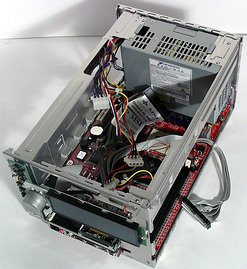 Now, looking at the photos imagine the following picture: above is a 5" drive pressed to the power supply unit, below closely sits a hard drive, the CPU cooler almost touches the lower edge of the power supply unit, and such system literally sits on an AGP video card the sinks of which press power supply and interface cables into the side vent of the power supply unit. The AGP slot located closer to the PCB center allows for using a video card with a twice wider cooler, but any extension card installed into this slot automatically blocks air supply to the fan on the CPU cooler. 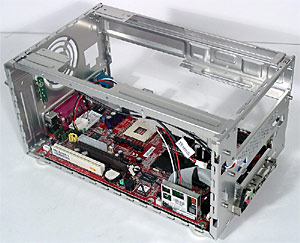 The power supply cables, as well as other cables spreading from the back side to the front one worsen the internal design even more. Thus, installation of a video card turns into a real deed (not to mention the fact that it's necessary to precisely measure the card to see if it fits in at all). As a result, four air vents of the power supply unit get blocked: two by the PC panel, one by the video card and cables, and the forth one is too close to the board's surface. The only components that are easy to install are memory modules: two slots are located near the board's edge and are easily reachable even when the PC case is filled up with components. However, the installation procedure is carefully described in the well illustrated user manual.  The Mega PC 651 (MS-6760) mainboard is based on the SiS651 chipset (SiS651 + SiS962), i.e. it's not a top product. It supports Celeron/Pentium 4 with the FSB clock up to 533 MHz, memory up to DDR333 (two modules), USB 2.0, FireWire (2 ports), Fast Ethernet (up to 100 Mbit/s, Realtek 8101L controller), and 6-channel audio (ALC650 codec). The integrated video accelerator of the SiS315 chipset can be just jokingly called an accelerator, but it suits for an office use as the 2D image at 1024x768x32@100Hz is pretty good. Theoretically, the Mega PC has one AGP and one PCI slots for full-size expansion cards. There's also onboard Actiontec's MC'97 modem based on the Agere chip (on the left on the pic above).  We didn't thoroughly examined the modem, but when we selected our country in the driver settings it detected the busy signal and managed to maintain connection on the average-quality phone line. Finally, the barebone system gets energy from the 250W power supply unit produced by FSP Group Inc. The first lots of the Mega PC had a 200W power supply unit, and a part of those lots were withdrawn because of the power supply problems. We tested our sample in the heavy conditions (using a more powerful processor than the specs allow) and found no signs of the problem. Temperature mode or noiseExamining the chipset's and board's potential further we tested the Pentium 4 3.06 GHz with the Hyper-Threading enabled. Note that Pentium 4 2.8 GHz is specified as the maximum allowable processor, and secondly, the first revision of the SiS651 chipset didn't supported the Hyper-Threading. 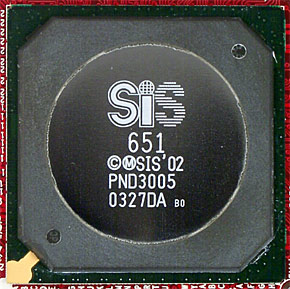 But this barebone has the B revision of the chipset, that is why we easily got the virtual dual-processing and tested the computer exactly in this mode. The hard drive, DVD-ROM and ATI Radeon 9800Pro based video card (almost the fastest accelerator at the moment) put a decent thermal load on the Mega PC. What cooling means could conquer all those hot components? The chipset's bridges are covered with heatsinks (the north bridge has a fan as well), as well as transistors in the CPU power supply circuit (typical of MSI). There is also a blowing-out 80mm fan of the power supply unit located behind, and a CPU cooler. 
 The cooler is attached not to the Socket 478 holder but to two frames screwed to the PCB (by the way, it's not handy to hook up the cooler, and it's almost impossible without a screwdriver). This cooler consists of an aluminum sink with high and almost straight fins covered with a jacket which helps in drawing air out of the case (through two vent holes on its side). On the opposite side there's a 60mm fan (Delta Electronics AFB0612VHC, up to 5400 rpm, 28 CFM, 38 dBA) for blowing air through the fins. We mentioned already the problems, that is why it's hard to blame exactly the cooler for low thermal efficiency. Let's see what this MSI Mega PC's cooler (which also includes IDE cables tightened in a bun) able of. The figures are not pleasant, especially considering that they were taken in the standby mode (after rebooting the system and entering the BIOS). Unfortunately, none of the known utilities could correctly recognize a motherboard monitoring module, that is why we used what we could see here. The PC case, when paired with the Radeon 9800Pro card, gets too hot. But I think that replacing the top-level Radeon with a less-efficient card can't help - I guess it's because the CPU cooler input is blocked. We recommend that you don't use the top models. Both processor and video accelerators should be taken from the middle of a line, and the AGP slot should be left free. By the way, for the TYAN Tachyon G9600 PRO 128MB card that supports hardware monitoring we got the following figures: VPU - 36/40°C, memory - 38/42°C in the standby/operating modes (compare with the normal figures for this card). In the standby mode and with the integrated graphics the PC works pretty quietly, but when coupled with the hot external accelerator it makes quite a lot of noise even in the BIOS (the regulated speed of fan rotation makes 3300 and 4700 rpm). When the processor gets load, the first cooler that turns on is its own, then the system enables the cooler in the power supply unit. Add the noise made by the video card's cooler. However, such noise is noticeably lower than that of top industry monsters. Also remember that in the audio center mode the system doesn't get warm or make noise. At all. :) PerformanceTestbed:
Software:
For barebone systems we first of all estimate how much the speed falls down with the integrated graphics in typical memory controller tests and also measure relative and absolute system scores in 3D games. The scores are typical of most integrated chipsets (except NVIDIA nForce/2): the integrated graphics cuts off the performance of the Mega PC by 15%. However, far not all real tasks are so sensitive to the memory speed. If you want to play modern 3D games you have no choice: the SiS315 is not efficient enough. Looking at the tests with the external video card keep in mind what we said above about the top components. The diagrams show scores in different resolutions only if the speed much depends on them. Brief characteristics of the barebone system

ConclusionIn general, the impression of the Mega PC is positive. I'd change many things here, but still, this system looks pretty interesting for its class (which hasn't formed yet). It's not cheap and you should weigh both advantages and disadvantages of such combination of two functions. Highs:
Lows:
Write a comment below. No registration needed!
|
Platform · Video · Multimedia · Mobile · Other || About us & Privacy policy · Twitter · Facebook Copyright © Byrds Research & Publishing, Ltd., 1997–2011. All rights reserved. |